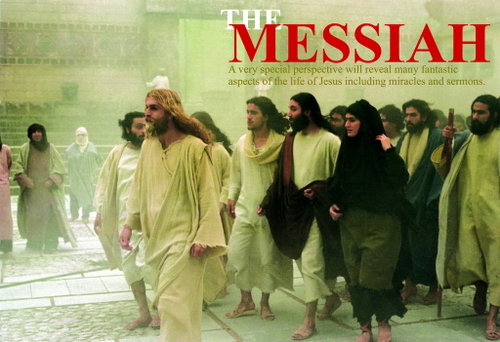The following is a chapter from Screen Jesus, our regular contributor Rev Peter Malone’s in-depth study of depictions of Jesus on screen, both silver and television, over the history of the cinematic arts. The book is available from Scarecrow Press or from your favorite book retailer. We will be featuring on ongoing series of excerpts from the book courtesy of Rev. Malone.
____________________________________________________________________________________
 Western film buffs were surprised at the Fajr Film Festival in Tehran in 2005 to find a Jesus film. It was Nader Talebzadeh’s The Messiah, a two hour film cut down from a 10 hour miniseries. This should not have been completely unexpected since there had been a film/miniseries called Saint Mary (2002), a portrait of Mary, Mother of Jesus, based on the Koran.
Western film buffs were surprised at the Fajr Film Festival in Tehran in 2005 to find a Jesus film. It was Nader Talebzadeh’s The Messiah, a two hour film cut down from a 10 hour miniseries. This should not have been completely unexpected since there had been a film/miniseries called Saint Mary (2002), a portrait of Mary, Mother of Jesus, based on the Koran.
Talebzadeh continued to work on his Messiah, especially engaging in dialogue with Christian audiences. By 2007, he had filmed a second ending using Christian sources. It was inserted preceding his original ending based on Islamic sources and the Gospel of Barnabas. Screenings of this film, now titled Jesus the Spirit of God, followed by discussions, took place in Europe and North America during 2007.
Jesus, the Spirit of God stands as an interesting version of the Gospels as well as having its Muslim perspective, especially in the role of Jesus as a Prophet who was not the Son of God but a great prophet who foreshadowed Mohammad. The quotations are taken from the English subtitles for the film.
Jesus, Preacher and Healer
The portrait of Jesus is dignified and quite serious. Jesus does not laugh. A voiceover commentary introduces him as he walks through green hills with a staff and a choral background. We are told that the Prophet of Galilee is beginning his mission. He calls some of the apostles, especially by the sea of Galilee. Philip is a shepherd. Barnabas comes from Cyprus and John from eastern countries. Judas is chosen and described as not benefiting from being blessed with faith. Jesus speaks of worship, the beatitude concerning mourners, concerning the poor who have turned from worldly enjoyments to eternal enjoyments, concerning wayfarers. People flock to Jesus.
 Included is a healing story, a woman coming to Jesus pleading and weeping, asking for a cure for her deaf and mute sister. Jesus is silent, quietly bows. He is like an icon and watches. After the cure, the people crowd around to touch him. Jesus goes into the Temple, raises his arms in the manner of the familiar statues and praises God, the creator, and the Holy Name of God. He praises Moses the mediator of the law. But he condemns the heads of the priesthood and reproaches the scribes and Pharisees for their false interpretations of the law.
Included is a healing story, a woman coming to Jesus pleading and weeping, asking for a cure for her deaf and mute sister. Jesus is silent, quietly bows. He is like an icon and watches. After the cure, the people crowd around to touch him. Jesus goes into the Temple, raises his arms in the manner of the familiar statues and praises God, the creator, and the Holy Name of God. He praises Moses the mediator of the law. But he condemns the heads of the priesthood and reproaches the scribes and Pharisees for their false interpretations of the law.
Another miracle follows. A hunchbacked woman is presented. Jesus raises his hand in blessing. The apostles watch silently. Gradually, the woman unbends and rises. Jesus is referred to as adopted Son of Joseph, healer of Mary Magdalene and that the saviour of the world is here.
At this point a story based on the Acts of the Apostles is inserted, an argument in the Sanhedrin where Gamaliel, against Caiaphas, advises not doing battle with Jesus or killing him – let time pass and it will reveal the truth.
A different kind of miracle occurs out in the desert with the disciples asking for food from heaven. Now Jesus speaks directly and in his own voice. He kneels, prays, quoting God as sending food down and warning that those who do not believe will be chastised. This echoes the manna in the desert as well as Jesus’ references to food from heaven in John 6 as well as an anticipation of the condemnation of Judas. After a long gaze at the skies, Jesus sees a lavish banquet laid out on the ground and the apostles eat. Judas does not (and the screenplay adds a rare touch of humour when one of the apostles urges him on, reminding him that he does not have to pay). While Jesus prays thanksgiving, Judas runs away calling it all a mirage.
 Towards the Crucifixion
Towards the Crucifixion
A long section follows where Jesus goes into the temple on the eve of Passover – a roasting lamb is shown. There are accusations that Jesus lies. He defends his telling of the truth. Once again, he speaks of Mohammad, the final prophet who is descended from their great ancestor, Isaac. He will tell the truth. Jesus asks why they rebuke him as an enemy rather than as a brother. ‘If I work iniquity, reprove me.’ The elders of the Sanhedrin ask him whether the great ancestor is Isaac or Ishmael, the father of the Arabs. Jesus says that the messiah must be descended from Ishmael and that he is his messenger. Uproar ensues as they pick up stones to hurl at Jesus. He passes from them and, blinded, they throw the stones at each other.
It is at this stage, Caiaphas tries to buy off Pilate. Pilate rejects the claim that the Jews and Romans have common interests and taunts Caiaphas, ‘the unseen God you are always talking about is greed’. The whole proposal is a good bargain but a bad deal: ‘you want me to incriminate someone who has not broken Roman law’. Pilate says there will be a permanent stain on them.
 The next scene is somewhat surprising for Christian audiences. In the woods, Jesus tells the apostles he will be leaving them soon and that they should keep faith during his absence. He adds (in the words of John’s Gospel), ‘I will ask the merciful God to send the Comforter. He will remind you of all I have said and bear witness to the truth of my teachings’. Here is an interesting area for discussion between Christians and Muslims on the Comforter (the Spirit).
The next scene is somewhat surprising for Christian audiences. In the woods, Jesus tells the apostles he will be leaving them soon and that they should keep faith during his absence. He adds (in the words of John’s Gospel), ‘I will ask the merciful God to send the Comforter. He will remind you of all I have said and bear witness to the truth of my teachings’. Here is an interesting area for discussion between Christians and Muslims on the Comforter (the Spirit).
At the Last Supper, Mary Magdalene brings the perfume and liberally showers Jesus with it. Judas shakes his head and claims that thirty people could have been fed with its cost. Jesus tells Judas that he knows what is in his heart. Judas now goes to Caiaphas and is announced, ‘His Excellency, Judas son of Iscariot, is at your service’. Caiaphas offers thirty silver coins. The voiceover at the supper says that this year was different for the apostles. As Jesus washes the feet, it continues that it was destined that Jesus have a Last Supper.
The Christian Ending
It is at this point that the screen states, ‘Continuation of events according to the Christian narrative’.
This is quite brief. The Romans come to the supper room, manhandle Jesus and take him to the court where there are cries of denunciation, ‘The cure for this accursed man is the lashings of the Romans’. Jesus is silent as Pilate speaks, saying that he does not want to crucify him, that he does not want to be blamed for Jesus’ murder. The guards spit at Jesus. He is scourged. And scenes of the treasure bribe being carried in for Pilate are intercut. Pilate says he hope thinks people will change their minds when they see Jesus’ broken body.
They do not. Jesus carries his cross, women follow him. In a brief sequence he is seen raised from the dead.
 The Islamic Ending
The Islamic Ending
Now, at this point, the screen states, ‘Continuation of events according to Islamic sources and the Gospel of Barnabas’. There are some great surprises now for audiences not familiar with these sources.
Jesus reflects on people wanting to kill him and prays to God that he may be saved from their snares. The angel Gabriel appears and explains God’s plan for Jesus’ suffering, ‘Son of Mary, I shall take you from this world and purify you’. Jesus sees a bright light. ‘Your appointed time has come.’ Jesus walks into the light.
Now Judas returns and the apostles are sleeping. The bright light turns on Judas who screams and is transformed ‘in speech and face’ into the form of Jesus.
The film returns to the Romans coming to the door. Judas/Jesus is arrested, protesting that Jesus has escaped. He is mocked, called a ‘heathen’, struck and lashed. (There is a short interlude where a soldier accosts the terrified Peter, ‘have you seen a jinn?’. Peter says, ‘I am still his disciple but that man in not my teacher’.)
When Judas/Jesus is with Pilate, Pilate’s officer says he is talking nonsense and is an idiot. Pilate says that his eyes testify but his inner conscience says this man bears no resemblance to Jesus. The people cry out for his death. Pilate expresses the dilemma when Judas says he has been transformed by Jesus’ sorcery: that if this is truly Jesus, then he has lost his understanding and it is cruel to kill a mad man, he deserves pity. However, the Sanhedrin declares it is Jesus and that they take full responsibility.
The crucifixion follows with the voiceover comment, ‘God set a seal on the cruel hearts of the people of Israel because they killed (not him but who appeared so) the Messenger of God, Son of Mary. Jesus/Judas cries out from the cross that God has abandoned him.
There is a resurrection epilogue with a reference to a Koran sura that God raised Jesus – and we see the risen Jesus, in the company of his disciples.
Jesus, Spirit of God (and the miniseries) is a different contribution to the Jesus films and opens up avenues for interfaith theological dialogue.

